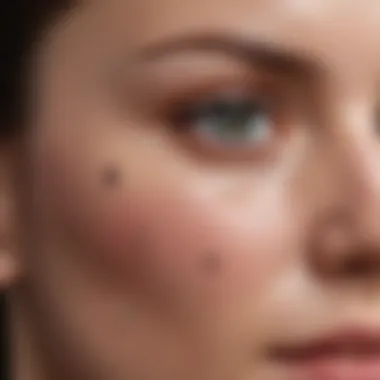Exploring the Efficacy of Retinol in Treating Blackheads


Intro
The skincare world is constantly evolving, with new treatments and ingredients emerging regularly. Among these, retinol stands out as a potent contender against various skin concerns, including blackheads. Blackheads form when pores become clogged with excess oil and dead skin cells, leading to their distinctive dark appearance on the skin's surface. Understanding how retinol works can illuminate its role in maintaining skin clarity and health.
In this article, we will delve into the efficacy of retinol for addressing blackheads, examining its mechanisms, advantages, and possible side effects. By analyzing retinol's impact, readers can better assess its suitability for their unique skin types and needs. Furthermore, we aim to discuss effective ways of integrating retinol into skincare practices, alongside complementary treatments and lifestyle choices that can bolster its effects.
Understanding Blackheads
Understanding blackheads is critical in determining effective treatment methodologies, including the role of retinol. Blackheads are a common skin concern that many people experience at some point in their lives. They are often regarded as merely cosmetic nuisances, but their underlying causes can indicate broader skin health issues. By comprehending what causes blackheads and who is most affected, we can tailor treatments specifically to address these concerns.
To address blackheads effectively, it is crucial to delve deeper into their definition. When we know what blackheads are, we can outline treatment methods, such as retinol, more effectively. Additionally, exploring the demographics affected can help in formulating products catering to specific age groups and skin types, which can enhance user satisfaction.
Definition of Blackheads
Blackheads are open comedones, a type of acne that forms when hair follicles become clogged with oil and dead skin cells. Unlike whiteheads, which are closed comedones, blackheads have a dark top due to the oxidation of melanin when exposed to air. This characteristic sets them apart and identifies them visually in a way that allows for easy differentiation from other skin issues.
Causes of Blackheads
Identifying the causes of blackheads is essential for establishing an effective treatment plan. They often result from a combination of factors that disrupt the delicate balance in skin health.
- Excess Oil Production: Excess oil production is a primary contributor to blackhead formation. Sebaceous glands, when overactive, generate more oil than the skin requires. This condition can lead to clogged pores and subsequently, the formation of blackheads. While oil is necessary for skin lubrication, an overabundance can create problems, making it a key consideration for those dealing with blackheads.
- Dead Skin Cells: Dead skin cells also play a significant role in the development of blackheads. When skin cannot shed itself properly, these cells accumulate in hair follicles, contributing to blockages. Effective exfoliation can help manage this, but many do not realize its importance in preventing blackheads.
- Bacteria: Bacteria can exacerbate the situation by causing inflammation within follicles. While blackheads are not infected like cystic acne, the presence of bacteria can create conditions that worsen the skin's overall appearance. This aspect of blackheads is often overlooked in treatment discussions.
Demographics Affected by Blackheads
Understanding demographics is crucial when examining who suffers from blackheads. Recognizing age groups and skin types that commonly experience this issue helps tailor specific treatments.
- Age Groups: Blackheads are often prevalent during puberty due to hormonal changes. However, they can persist into adulthood, affecting a wide array of individuals. Knowing this can help target solutions more effectively based on age-related skin concerns.
- Skin Types: Different skin types react uniquely to blackhead formation. Oily skin types are more susceptible to blackheads due to naturally higher oil production. Conversely, those with dry skin may see fewer blackheads but can still experience clogging and blackhead formation. This understanding is essential for developing serious treatments.
What is Retinol?
Understanding what retinol is, is key in discussing its role in skin care, especially regarding blackheads. Retinol, a derivative of vitamin A, has long been recognized for its effectiveness in promoting skin health. It is essential to understand its properties, benefits, and how it fits into topical treatments for blackheads.
Overview of Retinol
Retinol helps in enhancing skin texture and promoting cellular turnover. This means it aids in shedding dead skin cells and improving the overall appearance of the skin. Such qualities make it a critical component in many skin care routines aimed at combating issues like blackheads.
Sources and Forms of Retinol
Topical Forms
Topical forms of retinol are the most commonly used in skin care routines. These products come in various formulations, including creams, serums, and gels. One major characteristic of topical retinol is its ability to penetrate the skin effectively, delivering the vitamin directly to the areas where it is needed most.
This direct delivery is particularly beneficial for targeting blackheads, as it not only helps in unclogging the pores but also promotes the shedding of dead skin that contributes to their formation. Many users prefer topical retinol due to its ease of application and immediate access to the skin's surface. However, it is important to consider potential skin irritation as a disadvantage of these formulations, especially for individuals with sensitive skin.
Oral Supplements
Oral supplements of retinol offer another means of incorporating this vital compound into one’s skincare approach. What differentiates oral supplements is their systemic effect. These supplements provide the body with retinol that can influence skin health from the inside out.
Though they are not as popular as topical forms in treating blackheads, oral supplements can still play a supportive role in maintaining skin health. Yet, one must approach oral intake with caution due to possible side effects or overdoses if not properly monitored.
How Retinol Works on the Skin
Understanding how retinol operates at the cellular level is fundamental for appreciating its role in treating blackheads. Retinol, a derivative of vitamin A, interacts directly with skin cells to promote healthier skin and tackle common issues like blackheads. By stimulating certain processes in the skin, retinol brings forth multiple benefits that can significantly improve both the appearance and texture of the skin.


Cell Turnover Enhancement
One of the key ways retinol works is by enhancing cell turnover. The skin naturally sheds dead cells, but this process can slow down with age or certain skin conditions. When retinol is applied, it accelerates the rate at which new cells are generated and old cells are exfoliated. This action effectively prevents the clogging of pores.
Speeding up cell turnover means that the skin can renew itself more efficiently. Fresh skin emerges more quickly, contributing to a brighter and smoother complexion. Furthermore, as the dead skin cells are shed more rapidly, there is less risk of them mixing with excess oil and forming blackheads. Retinol can thus play a pivotal role in maintaining a clear complexion.
Unclogging Pores
Another important benefit of retinol is its ability to unclog pores. Blackheads form when oil and dead skin build up in hair follicles. Retinol penetrates the skin and facilitates the breakdown of this build-up.
By reducing the thickness of the outer layer of skin, retinol allows for easier extraction of trapped substances in the pores. This unclogging means fewer blackheads can form, leading to healthier-looking skin. Regular use of retinol can lead to fewer instances of blocked pores over time, which is valuable for anyone struggling with persistent breakouts.
Reducing Oiliness
Retinol also assists in regulating oil production in the skin. Excess oil can contribute significantly to the formation of blackheads. Retinol works by modulating the function of sebaceous glands, decreasing the amounts of oil that the skin produces.
By touting a more balanced oil level, retinol helps maintain a cleaner environment for the skin, further reducing the chance of blackheads. Individuals looking for a solution to oily skin may find retinol to be an effective approach, as it not only mitigates excess shine but also helps target the root cause of blackhead formation.
Regular incorporation of retinol in skincare has the propensity to enhance overall skin clarity and texture, leading to a marked improvement in skin health.
Benefits of Retinol for Blackheads
The role of retinol in treating blackheads is significant. Users often notice a marked improvement not only in the appearance of their skin but also in its overall health. Understanding these benefits can help individuals decide if retinol is the right choice.
Improvement in Blackhead Appearance
Retinol is known for its efficacy in reducing the visibility of blackheads. It works by enhancing cell turnover, which means it helps the skin shed dead skin cells more efficiently. By preventing the accumulation of these cells, retinol minimizes the chances of clogged pores, the leading cause of blackheads. Over time, consistent use results in smoother, clearer skin.
One of the most appealing aspects of retinol is its clinical backing. Studies have shown that retinol can visibly reduce the formation of comedones, the scientific term for blackheads. It not only helps in refining the surface texture but also contributes to a more even skin tone. This is important for those who seek a clearer complexion, as the presence of blackheads can often create a dull or uneven appearance.
Additional Skin Health Benefits
Besides improving the appearance of blackheads, retinol also offers other significant skin health benefits.
Reducing Fine Lines
Retinol is celebrated for its ability to reduce fine lines. This property makes it a favorite in anti-aging products. As retinol promotes faster cell turnover, it helps to stimulate collagen production. Increased collagen leads to more plump skin, which inherently reduces the visibility of fine lines. The consideration for those who struggle with premature aging is profound.
A key characteristic of retinol in this context is that it is scientifically proven, having a reputation built on extensive research. While effectiveness is a primary concern, it is worth acknowledging potential skin irritation, especially for those with sensitive skin. Gradual introduction into a skincare routine is often recommended to mitigate such effects.
Enhancing Skin Texture
This aspect of retinol enhances not just the appearance of skin but also its feel. With regular use, the texture improves, making the skin appear more refined. Uneven texture can contribute to the overall assessment of skin quality, so enhancement in this area is also crucial.
The unique feature of retinol is that it actively works on various skin concerns simultaneously. Users often find that smoother skin results in greater ease of makeup application and less reliance on heavy coverage products.
In summary, the benefits of retinol for blackheads extend into improving overall skin health. Whether through the reduction of fine lines or enhanced texture, retinol is seen as an effective agent in elevating skin quality.
Potential Side Effects of Retinol
Understanding the potential side effects of retinol is critical for anyone considering its use in their skincare regimen. While retinol offers several benefits, it is not without risks. Knowledge of these side effects ensures users can prepare, adjust their routines as needed, and make informed decisions about incorporating retinol into their program for treating blackheads and enhancing skin health.
Skin Irritation


Skin irritation is one of the most common side effects of retinol. This can manifest as redness, dryness, peeling, or a burning sensation. The irritability often occurs, particularly for those new to retinol. This reaction is typically due to retinol's potency in promoting skin cell turnover, which can be too intense for some. A gradual introduction to the product is advised. Start with lower concentrations and increase usage frequency as skin tolerates the product. Individuals with sensitive skin may want to opt for formulations designed for such skin types.
Photosensitivity
Another important consideration with retinol is photosensitivity. Retinol can increase the skin's sensitivity to sunlight, leading to a higher risk of sunburn or increased pigmentation. It is essential for users to apply sunscreen daily, especially during the initial phase of retinol usage. Protective measures like wide-brimmed hats or avoiding direct sunlight during peak hours may also be beneficial. Familiarity with this aspect promotes more effective and safer use of retinol.
Initial Breakouts
Initial breakouts can occur with retinol use. Some people may experience purging, where existing comedones and impurities rise to the surface as the skin cell turnover accelerates. This can be alarming, but it's typically a temporary phase. Patience is key. Users should continue their routine while monitoring skin changes. Should the breakouts persist or worsen, consulting a dermatologist is wise. This approach allows for tailored adjustments and might introduce alternatives if necessary.
"Being aware of potential side effects can significantly enhance the retinol experience, making it a tool for effective skin health rather than a source of frustration."
Combining this knowledge with proper application techniques can optimize the effects of retinol, especially in managing blackheads. Ensuring that the routine is well-thought-out and adapted according to skin reactions will help achieve the desired outcomes without adverse effects.
How to Incorporate Retinol into Your Routine
Understanding how to effectively add retinol to your skincare regimen is crucial for maximizing its benefits while minimizing potential side effects. Retinol can significantly enhance skin texture and tone, but knowing how to integrate it properly into your routine is essential for long-term success. This section will explore the necessary steps: choosing the right formulation, mastering application techniques, and determining the appropriate frequency of use.
Choosing the Right Formulation
Selecting the appropriate retinol formulation can vary based on skin type, sensitivity, and desired results. Numerous options are available, ranging from prescription-strength retinoids to over-the-counter creams and serums.
- Consider Skin Type: Oily, dry, sensitive, and combination skin can react differently to retinol. People with oily skin might benefit from formulations with higher concentrations, while those with sensitive skin should consider lower strengths or encapsulated forms to reduce irritation.
- Types of Retinol Products: Retinol is available in several formats, including creams, gels, and oils. Each format offers unique benefits. For example, gels often absorb quickly and may suit those with oily skin, while creams provide better hydration for dry skin types.
- Additional Ingredients: Look for formulations that contain skin-soothing ingredients like hyaluronic acid or niacinamide. These can help counteract dryness or irritation that retinol might cause.
Application Techniques
Applying retinol correctly can optimize its effects and minimize discomfort. Here are some essential techniques:
- Start Slowly: Begin by applying retinol once or twice a week. As your skin builds tolerance, gradually increase frequency.
- Clean and Dry Skin: Always apply retinol to clean, dry skin. Wait about 20-30 minutes after washing your face to ensure your skin is completely dry. This reduces the risk of irritation because wet skin can enhance penetration, potentially leading to more side effects.
- Use Pea-Sized Amount: A small amount, typically the size of a pea, is sufficient for the entire face. This promotes even application and minimizes wastage.
- Avoid Sensitive Areas: Keep retinol away from the delicate areas around the eyes and mouth, as these regions are more prone to irritation.
- Moisturizing: Consider applying a moisturizer before retinol for those new to it. This method, known as buffering, can create a protective barrier, easing the skin into the treatment.
Frequency of Use
Determining how often to use retinol is vital for discretion across individual skin types and concerns:
- Build Tolerance: In the beginning, use retinol only once or twice a week. After a few weeks, increase use to every other night or even nightly, depending on your skin's tolerance.
- Monitor Skin Response: Pay attention to how your skin reacts. If you experience excessive irritation, itching, or peeling, reduce the frequency. It is better to adjust the usage than to discontinue entirely.
- Consistency Matters: To achieve noticeable results, consistency is key. While retinol may deliver initial improvements within weeks, the most significant benefits often appear after several months of regular use.
In summary, incorporating retinol into your skincare routine should not be hasty. Proper selection of formulation, application, and adherence to frequency can significantly enhance its efficacy in treating blackheads. By taking these steps, you can pave the way towards achieving clearer, healthier skin.
Complementary Treatments for Blackheads
In the quest for clearer skin, it's essential to understand that topical treatments like retinol provide significant benefits; however, they often work best when combined with other complementary approaches. These treatments can enhance the efficacy of retinol by addressing the various factors that contribute to blackheads. Consideration of such methods helps in achieving more holistic results, leading to effective management of blackheads across diverse skin types.
Exfoliation Methods
Exfoliation is a fundamental process in skin care; it helps in removing dead skin cells and improving skin texture, which in turn can reduce blackhead formation. There are two primary types of exfoliation methods: physical and chemical.
Physical Exfoliants
Physical exfoliants involve the use of granules or tools to scrub away dead skin. A notable characteristic of physical exfoliants is their immediate, tangible effect on the skin’s surface. Many people appreciate this method for its simplicity and efficiency. Popular examples include scrubs containing sugar, salt, or microbeads.
One unique feature of physical exfoliants is their ability to provide instant smoothness and a brighter appearance to the skin. However, it's important to consider the potential disadvantages. Over-exfoliation can lead to irritation and compromise the skin's natural barrier. Therefore, moderation is crucial when adopting this technique in conjunction with retinol treatments.
Chemical Exfoliants


Chemical exfoliants use acids or enzymes to break down the bonds between dead skin cells, promoting their removal. Salicylic acid and glycolic acid are two common types of chemical exfoliants. One key characteristic of these agents is their targeted action beneath the skin's surface. This allows for deeper cleaning of clogged pores, which is especially beneficial for preventing blackheads.
The unique feature of chemical exfoliants is their ability to not only exfoliate but also provide additional skin benefits, such as improved hydration and enhanced cell turnover. Nevertheless, the use of chemical exfoliants requires careful consideration, as they may lead to skin sensitivity. It’s advisable to incorporate them slowly into your regimen, particularly alongside retinol.
Salicylic Acid
Salicylic acid is a beta hydroxy acid (BHA) known for its efficacy in treating blackheads. This compound penetrates deeply into pores, effectively dissolving excess sebum and dead skin cells. As a result, salicylic acid serves as an excellent complement to retinol, enhancing its ability to unclog pores and reduce blackhead appearance. Its anti-inflammatory properties can also help calm the skin, making it a popular choice among individuals with oily or acne-prone skin.
Clay Masks
Clay masks are another effective complementary treatment for blackheads. They draw out impurities and excess oil from the skin, working by absorbing sebum and toxins. Ingredients such as bentonite and kaolin are common in these masks; they not only help in detoxifying the skin but also provide a gentle exfoliation. The use of clay masks, especially periodically, can help create a cleaner pore environment, facilitating better penetration of retinol and overall skin improvement.
Lifestyle Considerations for Skin Health
Maintaining skin health goes beyond topical treatments. While retinol effectively addresses blackheads, it is essential to consider lifestyle factors that contribute to overall skin vitality. This section explores three main elements: diet and nutrition, hydration, and stress management. Each of these factors plays a role in maintaining skin clarity and balance, complementing the effects of retinol.
Diet and Nutrition
A balanced diet rich in vitamins and minerals influences skin health significantly. Nutrients such as vitamins A, C, and E are vital for skin regeneration and repair. Foods like leafy greens, nuts, and fruits provide antioxidants that combat free radicals. Additionally, omega-3 fatty acids found in fish like salmon can reduce inflammation and support skin hydration.
"Diet is not just about appearance; it impacts overall well-being and skin health."
Moreover, avoiding excessive sugar and processed foods can help reduce oiliness and pore congestion. Foods high in sugar can spike insulin levels, leading to increased oil production, which exacerbates blackheads.
Key Nutritional Strategies:
- Focus on Antioxidant-Rich Foods: Include berries, citrus fruits, and vegetables.
- Incorporate Healthy Fats: Seek out sources such as fish and avocados.
- Limit Processed Foods: Reduce intake of sugary and fried items.
Hydration
Proper hydration is crucial for skin elasticity and function. When the body is dehydrated, skin can look dull and tired, and it may be more prone to congestion. Drinking adequate water helps maintain skin moisture and can assist in reducing the appearance of blackheads. Dehydrated skin may send signals to the body to produce more oil, worsening acne conditions.
To promote hydration:
- Drink Enough Water Daily: Aim for at least eight 8-ounce glasses.
- Use Hydrating Products: Incorporate moisturizers that contain hyaluronic acid or glycerin which help retain water in the skin.
Stress Management
Stress can have a profound effect on skin health. It triggers a release of cortisol, the stress hormone, which can lead to increased oil production in sebaceous glands. This may ultimately result in more blackheads and breakouts. Effective stress management is necessary for maintaining skin clarity. Techniques such as mindfulness, yoga, and regular exercise can lower stress levels and improve skin condition.
Incorporate practices that promote relaxation:
- Mindfulness and Meditation: Spend time in quiet reflection to reduce stress.
- Exercise Regularly: Physical activity can help improve mood and skin health.
- Adequate Sleep: Aim for 7-9 hours of sleep per night to aid skin recuperation.
Ending
The conclusion of this article summarizes the essential aspects of using retinol for treating blackheads. Throughout the previous sections, it has been clear that retinol is a powerful tool in skin care. Its benefits extend beyond just treating blackheads; it also promotes overall skin health. The significance of this topic lies in the multifaceted approach one can adopt for clearer skin.
Summary of Findings
In reviewing the findings, retinol enhances cell turnover and aids in unclogging pores effectively. This is vital for individuals prone to blackheads, as these formations result from blocked hair follicles. The ability of retinol to reduce oiliness further complements its role in preventing future blackheads. Moreover, the additional benefits of reducing fine lines and enhancing skin texture can entice users to incorporate retinol into their routine.
Another key aspect is the potential side effects associated with retinol usage. Skin irritation and photosensitivity are common concerns. It is important to assess one’s skin tolerance before fully integrating retinol into a daily routine. Users can benefit by starting with lower concentrations and gradually increasing usage as skin adapts.
Final Thoughts on Retinol and Blackheads
In closing, retinol's efficacy in combating blackheads makes it an important consideration for anyone struggling with this skin issue. While it is an effective treatment option, individual experiences may vary. Therefore, understanding how to use retinol along with lifestyle considerations can significantly improve outcomes.
Consider the importance of complementary treatments such as salicylic acid and regular exfoliation. Lifestyle factors like diet, hydration, and stress management play a critical role in maintaining skin health.
In summary, combining retinol with a balanced skincare regimen and a healthy lifestyle can lead to noticeable improvements in skin clarity and texture. Ultimately, informed users can make the best decisions regarding their skincare needs.



